Shock of the old: 12 torturous and orgasmic exercise fads
YOUg, exercise. Must we? Apparently yes, but don’t worry, we can use props. Things were so terrible in the past that I assumed people didn’t need help staying fit because simply trying to stay alive presented enough cardiovascular and strength challenges – but no. “Exercise equipment first appeared in historical texts around 6000 BC. Health and fitness magazine.
Chinese martial artists lifted three-legged cauldrons, while the ancient Egyptians did so waved bags of sand above their heads and held them there, both of which look an awful lot like CrossFit to me (that’s me, someone who doesn’t know what CrossFit is). The Greeks have a lot to answer for too – including inventing the Olympic Games, of course – and the Romans got women involved, making them playing with balls and hoops.
Fortunately, things were more sedentary until the Renaissance, with its enormous infatuation with the Greeks and Romans, destroyed it. Vittorino da Feltre introduced exercise at his Mantua school “in all weathers” (typical gym teacher) in the first half of the 15th century, while Girolamo Mercuriale became dewy-eyed about the efforts in the ancient world in 1569 De Arte Gymnastics (The Art of Gymnastics), where all kinds of things are recommended ropes, dumbbells and stone slabs.
The rot had begun – and soon technology would help. In 1796 the ‘electrotherapist’ introduced Francis Lowndes invented the “Patent Gymnasticon”, a “machine for training the joints and muscles of the human body”. It involved an alarming number of wheels, flanges and pulleys. Advertisements suggested that the user, “while engaged in writing or reading, could keep his lower limbs in constant motion by the slightest effort, or by the assistance of a child.” Coincidentally, this is exactly how I like to move: sitting, reading, assisted by a child.
In the late 19th century, a quirky cartoonish strongman called Edmond Desbonnet opened its first “physical culture center,” with fixed and free weights and other resistance training equipment. It grew into a chain of more than 300 proto-gyms. From then on it was a brief, regrettable stumble for Joseph Pilates who attached springs to beds to create his reformer during World War I, and the modern tyranny of leg day.
Time for photos. Remember kids: the treadmill is designed to be… a prison sentence.
Bikini girls
There are more mutinous rolled eyes here than on a lower ranked netball team. I guess that’s what happens when a bright Roman spark introduces you to the concept of the “bikini body.” I especially like the grumpy ball throwers; the Greco-Roman opinion maker in the field of healthcare Galen wrote an entire treatise about it practice with a small ballclaiming that it was “extremely beneficial to health, producing a balanced condition, without any undue accumulation of flesh or excessive thinness.”
Velocipede
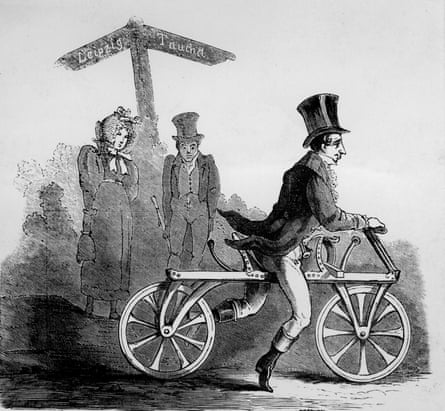
See the mighty vélocipede, or draisienne, a toddler balance bike for the 19th-century dandy. Invented by the nobleman Karl von Drais, later self-styled as ‘Citizen Karl Drais’ (he was extensively involved in the French Revolution), it was heavy and virtually impossible to steer, but enthusiastically adopted in the US. One doctor even called it “the great desideratum that will free our youth from muscular lethargy and atrophy”. Today’s roads were so rough that users took to the sidewalks, “to the horror of pedestrians” – a familiar sounding complaint.
Exercise machine
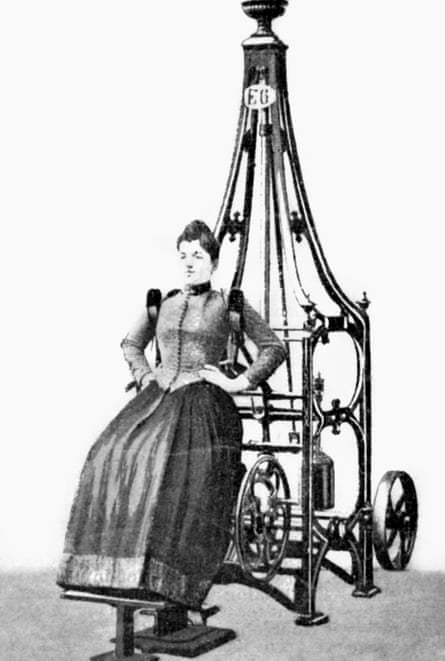
Photo: Granger/Shutterstock
The Swedish gym pioneer Gustav Zander devices designed to remedy “sedentary lifestyles and the isolation of the office,” promising “greater well-being and ability to work,” with the uncanny zeal of a Silicon Valley Chief Wellness Officer. Although it’s scary to think about, there is absolutely no evidence that users – often in full crinoline or heavy suits with pocket watches – are exerting themselves. Zander’s USP was that no effort was required; the machine did all the work.
Horse action saddle
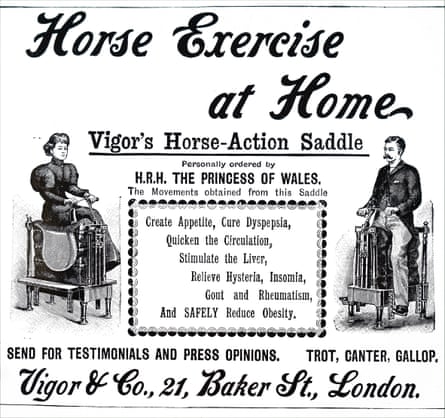
It’s a horse that can’t bite! There are his and her versions! He trots, gallops and gallops (but only if the rider makes it)! An 1897 advertisement claimed that Vigor’s horse action saddle was “a perfect substitute for the living horse,” which underplays the main selling points of horses: providing transportation and smelling wonderful. In all other respects though, this is a 10/10 and I’d love to try it.
Bath machine
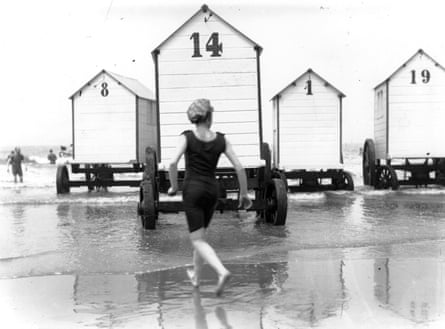
Bathing machines came onto the market in the 18th century when people foolishly decided to sink their fragile flesh into the sea – things live there, you know – and survived until the early 20th century. Being driven into the water in a shed and then raising the flag when you want to be towed out is a marked improvement over the modern “dry robes” business. I wish we still had “dippers” – women who dip you in the water, keep you afloat and then help you return to the bathing machine. Alfonso XIII of the Spanish bathing machine was so extensive that it looked a bit like Brighton Pavilion.
Bucking wild horse
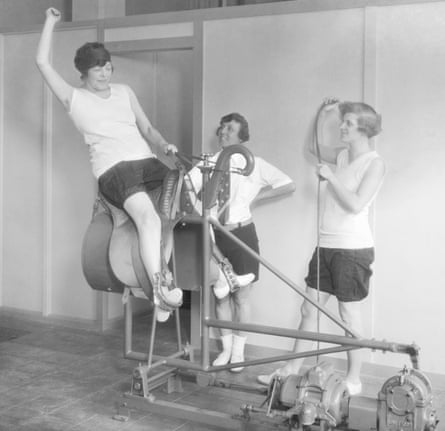
Thirty years after Vigor’s horse saddle, replicating a horse without a horse’s best parts was still a popular training strategy. The lady on the bucking bronco does Aileen Conquest-Allen (a divine name), not only an Olympic diver and silent film star, but also the coach of the US women’s track and field team for the 1928 Olympics. I hope she did it that way, even though this was supposedly “an exclusive gym class for members of the fashionable colony at Pasadena.”
Vibrating belt
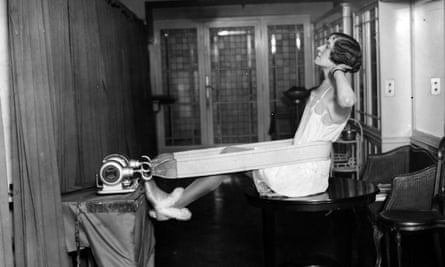
What do you mean, “if it takes place on the edge of a table while wearing fur-trimmed ankle boots, it’s not a drill”? I actually used one of these things with a vibrating belt – another Zander invention – once in a hotel gym in Lanzarote. It was as pointless as it seems, but I kept coming back because of the fascinating feeling of my thighs moving back and forth at warp speed.
The strut
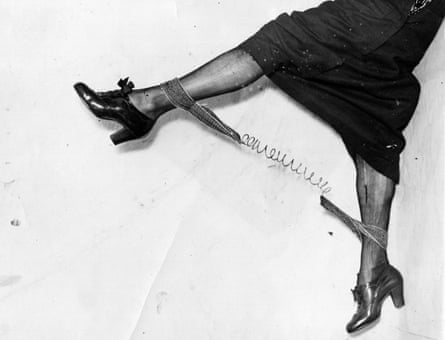
Designed to form the ‘perfect leg’, this 1935 device consists of just two Ikea bag handles connected by a thin spring: shoddy. You could certainly buy something similar – and be bitterly disappointed with it – via an Instagram ad. If I brought one home, I would have to hide it or my husband would just say, “You can to make That.” He once “made” an electric whisk from a coat hanger and a drill, with predictably catastrophic results.
Human hamster
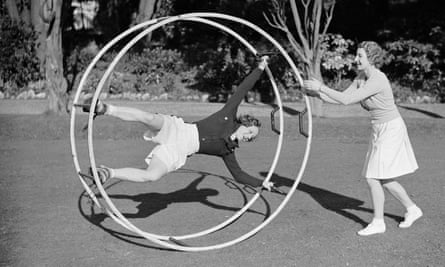
This 1936 photo shows “tennis player Miss Mary Heeley on a running wheel getting a push from fellow athlete Miss Hardwick.” I love their senseless exuberance, but as a veteran of a single disastrous Cyr wheel workout, I predict that Miss Heeley threw up 15 seconds after this shot into Miss Hardwick’s pristine sneakers.
Staying fit with Mrs. Garner
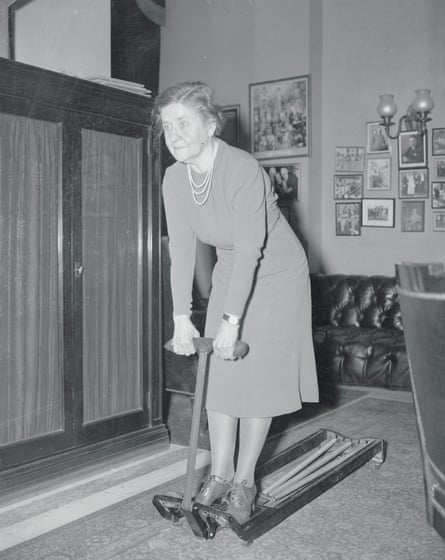
“How Mrs. Garner stays fit” is the caption here. “In three strands of pearls and a big heel,” apparently. Respect, ma’am. The caption also describes Garner and her husband — John Nance Garner, FDR’s first vice president — as “strict observers of the simple life,” but I feel like life would have been even simpler if she hadn’t had herself subjected to this rickety life. looking rowing machine device.
Nautical treadmill
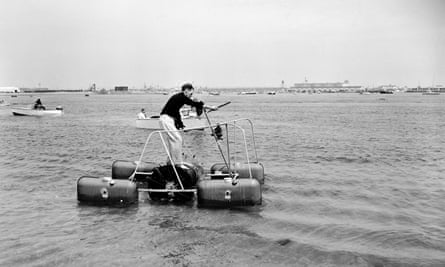
There’s a huge ‘Florida man’ energy in this hugely stupid ‘nautical treadmill’ (I prefer ‘death pedalo’) from 1953. The only redeeming features are Charles Smith’s stylish workout gear and flawless cheekbones. Think of an exercise machine that can give me that, sir.
